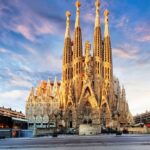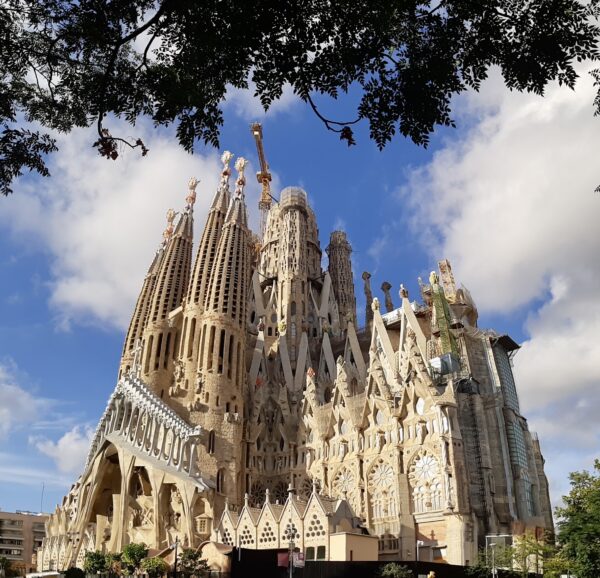
The Sagrada Familia stands as a testament to the genius of architect Antoni Gaudí, captivating millions of visitors each year. Its intricate design and towering spires make it a symbol of Barcelona's rich cultural heritage, blending Gothic and Art Nouveau styles in a way that is uniquely Gaudí.
As you explore this architectural marvel, you'll discover that The Iconic Sagrada Familia: Barcelona's Must-Visit Landmark is not just a church but a masterpiece in progress, with construction ongoing since 1882. Each detail tells a story, inviting visitors to immerse themselves in the artistic vision that continues to evolve.
The History and Significance of the Sagrada Familia in Barcelona
The Sagrada Familia was conceived by Antoni Gaudí in 1882, initially designed in a traditional Gothic style. However, as Gaudí became more involved in the project, his vision evolved, leading to a unique fusion of Gothic and Art Nouveau elements. This combination has made the basilica not only a place of worship but also an enduring symbol of innovation and creativity in architecture.
Throughout its construction, the Sagrada Familia has faced numerous challenges, including political upheavals and funding shortages. Despite these obstacles, the dedication to completing this masterpiece has never wavered. The basilica is designed to be an expression of faith, with each façade and interior space reflecting different aspects of Christianity, allowing visitors to experience a spiritual journey.
Today, the Sagrada Familia is a UNESCO World Heritage Site, celebrated not just for its architectural beauty but also for its cultural significance. It attracts millions of tourists annually, contributing to Barcelona's economy and enhancing its global reputation. Key features that highlight its significance include:
- Innovative Design: The use of natural forms and structures.
- Religious Symbolism: Each element represents Biblical stories and themes.
- Cultural Heritage: A reflection of Catalonia's identity and Gaudí's legacy.
As the Sagrada Familia approaches its completion, projected to be finished in the coming years, it continues to inspire both architects and visitors alike. Its ongoing construction serves as a reminder of the importance of art and faith in society, making it a vital part of Barcelona's historical and cultural landscape.
Exploring the Architectural Marvels of Gaudí's Sagrada Familia
Exploring the architectural marvels of Gaudí's Sagrada Familia reveals a complex interplay of forms and colors that challenge traditional notions of design. Gaudí's unique approach is evident in the basilica's organic shapes, inspired by nature, which create a sense of movement and fluidity throughout the structure. This innovative style not only enhances the visual experience but also reflects Gaudí's deep reverence for the natural world.
As you wander through the different façades, you'll encounter a rich tapestry of symbolism and artistry. Each side of the basilica conveys a distinct narrative:
- The Nativity Façade: Celebrating the birth of Jesus with intricate sculptures and depictions of nature.
- The Passion Façade: Portraying the suffering of Christ through stark, angular forms.
- The Glory Façade: Representing the resurrection and the glory of Jesus, still under construction.
The interior of the Sagrada Familia is equally breathtaking, featuring towering columns that resemble trees, creating a forest-like atmosphere. This design not only supports the edifice structurally but also enhances the spiritual experience for visitors, inviting them to contemplate and connect with the divine. The interplay of light through the stained glass windows further enriches this immersive environment, casting vibrant colors on the stone walls.
In summary, exploring the Sagrada Familia is akin to stepping into a living gallery where architecture meets artistry. Gaudí's visionary work continues to unfold, promising to reveal even more wonders in the years to come as construction advances. This masterpiece serves not only as a landmark but also as a beacon of creativity, inspiring future generations of architects and lovers of art alike.
A Visitor's Guide to the Sagrada Familia: Tips and Insights
Visiting the Sagrada Familia can be an unforgettable experience, but planning ahead is essential. To make the most of your trip, consider the following tips:
- Purchase Tickets Online: Avoid long queues by booking your tickets in advance.
- Choose Off-Peak Hours: Early mornings or late afternoons generally have fewer visitors.
- Guided Tours: Opt for guided tours to gain a deeper understanding of Gaudí's masterpiece.
When exploring the Sagrada Familia, take the time to appreciate its intricate details. Don't miss the opportunity to look up at the stunning ceilings, which are designed to resemble a forest canopy, creating an ethereal atmosphere. The use of light in the basilica enhances its spiritual ambiance, making your visit even more profound.
For those interested in photography, the Sagrada Familia offers countless opportunities to capture its beauty. Be sure to have your camera ready to take advantage of the changing light throughout the day. The golden hour, just before sunset, is especially magical, illuminating the façades in breathtaking hues.
Finally, consider exploring the surrounding area. The Sagrada Familia is located near several other attractions in Barcelona, including the enchanting Parc Güell and the bustling Passeig de Gràcia. A full day can easily be spent wandering through the unique architecture and vibrant neighborhoods that define this incredible city.
The Unique Symbolism Behind the Sagrada Familia's Design Elements
The Sagrada Familia's design is imbued with unique symbolism that reflects both faith and nature. Gaudí believed that architecture should mimic the natural world, which is evident in the organic shapes and forms throughout the basilica. Each element serves a purpose, from the towering columns resembling trees to the intricate façades that narrate biblical stories, creating a profound connection between the viewer and the divine.
One of the most striking aspects of the Sagrada Familia is its use of color and light. The stained glass windows are not merely decorative; they are purposeful, designed to invoke emotions and enhance the spiritual experience. As sunlight filters through these colorful panes, it casts an array of hues across the interior, transforming the space into a dynamic, living canvas that symbolizes the ever-changing nature of life and faith.
Additionally, the façades of the Sagrada Familia each convey distinct themes, adding layers of meaning to the overall design. For instance, the Nativity Façade emphasizes the joy and hope of Christ's birth, while the Passion Façade starkly contrasts this with its depiction of suffering and sacrifice. These thoughtful portrayals encourage visitors to reflect on the dualities of existence—joy and sorrow, life and death—making the basilica a profound spiritual journey.
In this way, the Sagrada Familia stands not only as an architectural masterpiece but also as a symbol of human aspiration. Gaudí's vision represents the intersection of art, religion, and nature, inviting everyone who visits to engage with these themes deeply. As the construction progresses, this iconic landmark continues to evolve, just as its meanings do, ensuring its relevance for generations to come.
Why the Sagrada Familia is a UNESCO World Heritage Site
The Sagrada Familia is designated as a UNESCO World Heritage Site due to its exceptional architectural significance and unique fusion of styles. Created by Antoni Gaudí, its design integrates elements of Gothic and Art Nouveau, showcasing innovative approaches that challenge conventional architectural norms. This blend not only exemplifies the creativity of Gaudí but also reflects the cultural identity of Catalonia, making it a vital representation of the region's heritage.
Another reason for its UNESCO status is the basilica's profound religious symbolism. Each façade, as well as the intricate details within the interior, narrates biblical stories that foster a deep spiritual connection for visitors. This intricate storytelling through architecture serves as a powerful medium for expressing faith, making the Sagrada Familia a significant place of worship and reflection for many.
Moreover, the ongoing construction of the Sagrada Familia exemplifies the spirit of dedication and collaboration in art. Since its inception in 1882, the project has garnered support from artisans, architects, and volunteers worldwide, all contributing to its completion. This collective effort not only highlights the importance of cultural preservation but also emphasizes the significance of continued artistic endeavor in an ever-changing world.
Finally, the Sagrada Familia's influence extends beyond its physical structure; it inspires countless architects and artists who visit to study its design and philosophy. This enduring legacy is a testament to Gaudí's vision and the spirit of innovation encapsulated within the basilica, ensuring that it remains not only a landmark in Barcelona but also a beacon of creative exploration for future generations.
Captivating Facts About the Sagrada Familia You Didn't Know
The Sagrada Familia is not just a feast for the eyes; it is also filled with captivating facts that many visitors might not be aware of. For instance, the basilica's design includes a total of 18 spires, symbolizing the Twelve Apostles, the Virgin Mary, the four evangelists, and Jesus Christ. This ambitious structure, once completed, will soar to a height of 172.5 meters, making it the tallest religious building in Europe.
Another intriguing aspect is the use of light as a design element within the Sagrada Familia. Gaudí meticulously planned how sunlight would interact with the interiors, employing stained glass windows that filter light in a spectrum of colors. This not only enhances the aesthetic appeal but also creates a spiritual ambiance, as the light seems to dance across the stone surfaces, inviting visitors into a contemplative experience.
Additionally, many may not know that the Sagrada Familia has been under construction for over 140 years, with an estimated completion date of 2026, marking the centenary of Gaudí's death. This prolonged construction period is a testament to the complexity of Gaudí's designs and the dedication of the artisans who continue to work on this monumental project. The ongoing efforts exemplify a blend of traditional craftsmanship and modern technology, ensuring that Gaudí's vision remains intact.
Finally, the Sagrada Familia features a variety of architectural styles, which blend Gothic and Art Nouveau elements in a unique manner. This innovative fusion not only reflects Gaudí's individual style but also pushes the boundaries of architectural norms. As a result, it has become a source of inspiration for countless architects and artists around the globe, solidifying its status as a true masterpiece of modern architecture.
 Discover the Majestic Sagrada Familia
Discover the Majestic Sagrada Familia Inside the Marvels of Barcelona: Exploring the Interior of the Sagrada Familia
Inside the Marvels of Barcelona: Exploring the Interior of the Sagrada FamiliaIf you want to know other articles similar to The Iconic Sagrada Familia: Barcelona's Must-Visit Landmark you can visit the category WHERE YOU CAN GO.
Leave a Reply










Read more!